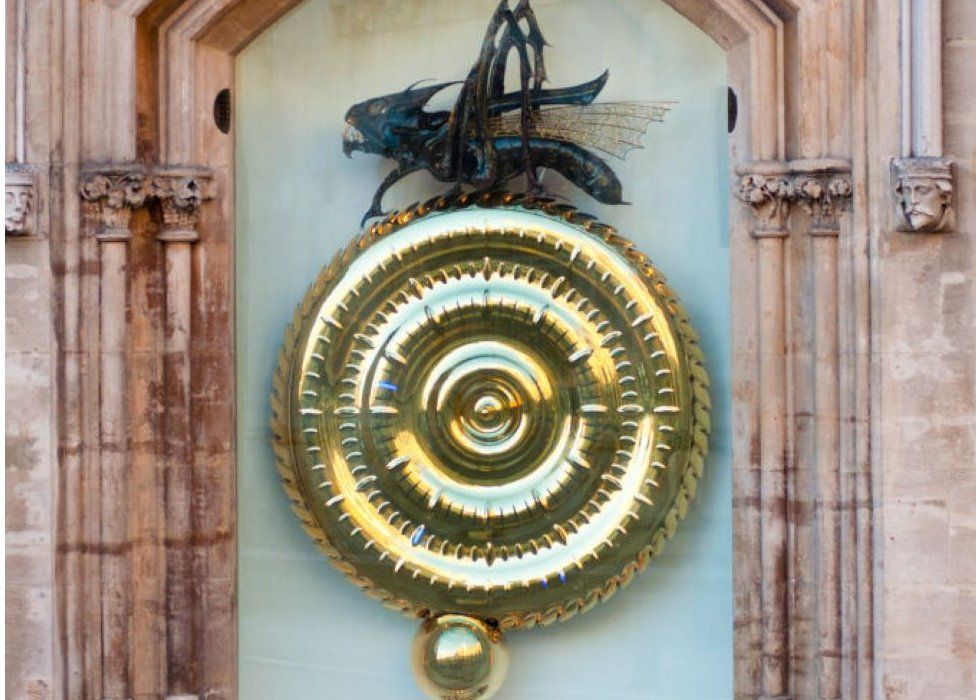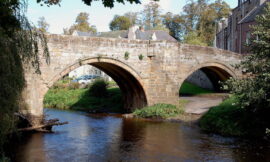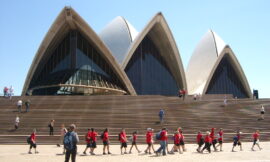The Corpus Clock, also known as the Chronophage, is a remarkable and innovative public timepiece located outside the Taylor Library at Corpus Christi College, Cambridge. Unveiled in 2008, this striking clock has become an iconic symbol of the city, drawing visitors and locals alike with its unique design and fascinating mechanism.
Historical Background
Conception and Creation:
- Inventor: The Corpus Clock was conceived and funded by Dr. John C. Taylor, an inventor and horologist who studied at Corpus Christi College. Dr. Taylor is known for his contributions to the development of the thermostat and other significant inventions.
- Unveiling: The clock was unveiled to the public on September 19, 2008, by the renowned physicist Stephen Hawking, adding to its prestige and significance.
Design and Features
Unique Appearance:
- Face and Structure: The Corpus Clock is notable for its gold-plated stainless steel face, which is approximately 1.5 meters in diameter. The face of the clock is designed to resemble a rippling, irregular surface, evoking the appearance of time itself as a fluid and ever-changing phenomenon.
- Chronophage: Atop the clock sits a large, grasshopper-like creature called the Chronophage (literally, “time eater”). This kinetic sculpture “crawls” around the edge of the clock face, symbolizing the relentless and unstoppable passage of time. The Chronophage’s mouth opens and closes, appearing to “eat” time as it moves.
Mechanism:
- Time Display: The clock displays time using a series of blue LED lights that illuminate through slits in the face of the clock, indicating hours, minutes, and seconds. The timekeeping mechanism is intentionally designed to be erratic, occasionally slowing down and speeding up, reflecting the relative and sometimes deceptive nature of time.
- Pendulum and Escapement: The clock’s mechanism is based on the traditional grasshopper escapement, a design created by the 18th-century clockmaker John Harrison. Dr. Taylor’s innovative interpretation incorporates a pendulum that regulates the movement of the Chronophage and the LED lights.
Symbolism and Interpretation
Philosophical Themes:
- Memento Mori: The Corpus Clock embodies the concept of “memento mori,” a reminder of the inevitability of death and the transient nature of life. The Chronophage’s relentless movement and the clock’s erratic behavior serve as a metaphor for the unpredictability and impermanence of time.
- Innovation and Tradition: By blending cutting-edge technology with traditional horology, the Corpus Clock symbolizes the fusion of innovation and tradition, a theme that resonates deeply within the historic and academic context of Cambridge.
Cultural and Educational Impact
Public Fascination:
- Tourist Attraction: Since its unveiling, the Corpus Clock has become a major attraction in Cambridge. Its striking appearance and unique concept draw tourists, students, and locals who marvel at its design and ponder its symbolic meaning.
- Educational Value: The clock also serves as an educational tool, sparking interest in horology, physics, and engineering. Its presence at Corpus Christi College underscores the college’s commitment to blending historical legacy with contemporary innovation.
Media and Recognition:
- Media Coverage: The clock has been featured in various media outlets, highlighting its artistic and technological significance. It has also appeared in documentaries and articles focused on innovative public art and engineering marvels.
- Awards and Honors: The Corpus Clock has received acclaim from the horological community and has been recognized for its design and engineering excellence.
Maintenance and Conservation
Upkeep:
- Regular Maintenance: Ensuring the proper functioning and preservation of the Corpus Clock requires regular maintenance. The clock’s complex mechanism and the outdoor setting necessitate periodic inspections and servicing to address any wear and tear.
- Conservation Efforts: The gold-plated stainless steel face and the intricate Chronophage sculpture require careful conservation to maintain their appearance and structural integrity. These efforts are essential to preserving the clock for future generations to appreciate and study.
Conclusion
The Corpus Clock is a unique and thought-provoking addition to the rich tapestry of Cambridge’s cultural and academic landscape. Its innovative design, blending of tradition and modernity, and deep philosophical symbolism make it a fascinating subject for visitors and scholars alike. As both a work of art and a technological marvel, the Corpus Clock continues to captivate and inspire, serving as a timeless reminder of the relentless and unpredictable nature of time itself.



